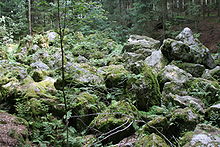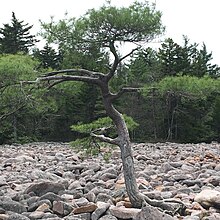
Back Caos (cheolochía) AN حقل الصخور Arabic Valun sahəsi Azerbaijani ब्लॉकफील्ड Bihari Kamenné moře Czech Felsenmeer German Ŝtona maro Esperanto Caos (geología) Spanish Kivikülv Estonian سنگپهنه Persian





A blockfield[1] (also spelt block field[2]), felsenmeer,[1] boulder field[1][2] or stone field[2] is a surface covered by boulder- or block-sized rocks usually associated with a history of volcanic activity, alpine and subpolar climates and periglaciation. Blockfields differ from screes and talus slope in that blockfields do not apparently originate from mass wastings. They are believed to be formed by frost weathering below the surface.[3][4] An alternative theory that modern blockfields may have originated from chemical weathering that occurred in the Neogene when the climate was relatively warmer. Following this thought the blockfields would then have been reworked by periglacial action.[4][5]
Most known blockfields are located in the northern hemisphere. Examples can be found in Abisko National Park in Sweden, Snowdonia National Park in Wales, the Great End-Scafell Pike ridge in England, and Hickory Run Boulder Field and River of Rocks in the Appalachian Mountains of the United States. All examples except the first one are outside present day subpolar climate areas, and have thus traditionally been seen as relict landforms from past times when these areas were under periglaciation.
The term "felsenmeer" comes from the German meaning "sea of rock". In a felsenmeer or blockfield, freeze-thaw weathering has broken up the top layer of the rock, covering the underlying rock formation with jagged, angular boulders. Freeze-thaw or frost weathering occurs when water that is trapped along microcracks in rock expands and contracts due to fluctuations in temperature above and below the freezing point. Felsenmeers are formed in situ, meaning that they are not transported during or after their creation.
- ^ a b c Whittow, John (1984). Dictionary of Physical Geography. London: Penguin, 1984, pp. 66 and 190. ISBN 0-14-051094-X.
- ^ a b c Leser, Hartmut, ed. (2005). Wörterbuch Allgemeine Geographie, 13th ed., dtv, Munich, pp. 107 and 221. ISBN 978-3-423-03422-7.
- ^ Thomas, David S.G. and Andrew Goudie (eds.), The Dictionary of Physical Geography, 3rd edn., Oxford: Blackwell, 2000, p. 215. ISBN 0-631-20473-3.
- ^ a b Goodfellow, B.W.; Stroeven, A.P.; Fabel, D.; Fredin, O.; M.-H., Derron; Bintnja, R.; Caffee, M.W. (2014). "Arctic–alpine blockfields in the northern Swedish Scandes: late Quaternary – not Neogene". Earth Surface Dynamics. 2 (2): 383–401. Bibcode:2014ESuD....2..383G. doi:10.5194/esurf-2-383-2014. Retrieved 11 July 2016.
- ^ Boelhouwers, Jan (2004). "New Perspectives on Autochthonous Blockfield Development". Polar Geography. 28 (2): 133–146. doi:10.1080/789610122. S2CID 129295656.